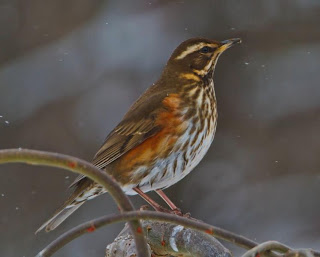 |
| Turdus iliacus |
The Redwing is rather obviously named for its reddish-brown wings and sides. The rest of the body is brown and buff, with streaking underneath. A pale line above the eye also helps the identify the species. The males and females look the same, and juveniles also look similar, but have more spots and less red.
The species is omnivorous, feeding on invertebrates in the summer and on seeds and nuts in the winter. The Redwings typically breed between April and July, and pairs usually are solitary. Up to six eggs are laid at once, and they hatch after two weeks. The chicks grow very fast, fledging after 15 days, and leaving their parents entirely when they are about a month old.
If you couldn't tell from the description of their location up above, the Redwing is incredibly widespread. Their overall range measures several million square miles, and the total population is somewhere around 63,000,000 birds! Needless to say they are listed as being of Least Concern.
IUCN Status : Least Concern
Location : Europe and Asia
Size : Body Length up to 9.5in (24cm)
Classification : Phylum : Chordata -- Class : Aves -- Order : Passeriformes
Family : Turdidae -- Genus : Turdus -- Species : T. iliacus
Family : Turdidae -- Genus : Turdus -- Species : T. iliacus
Comments
Post a Comment